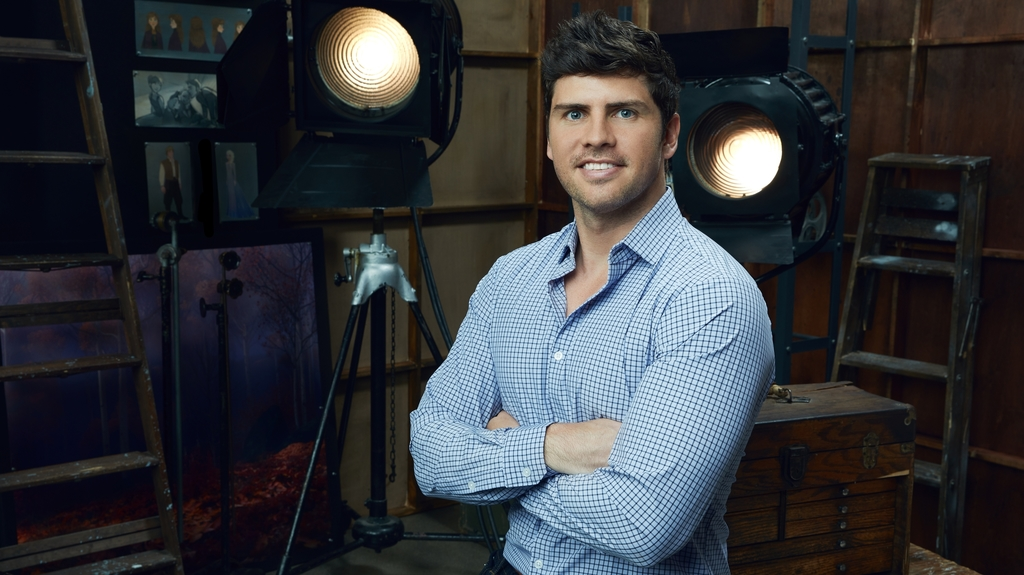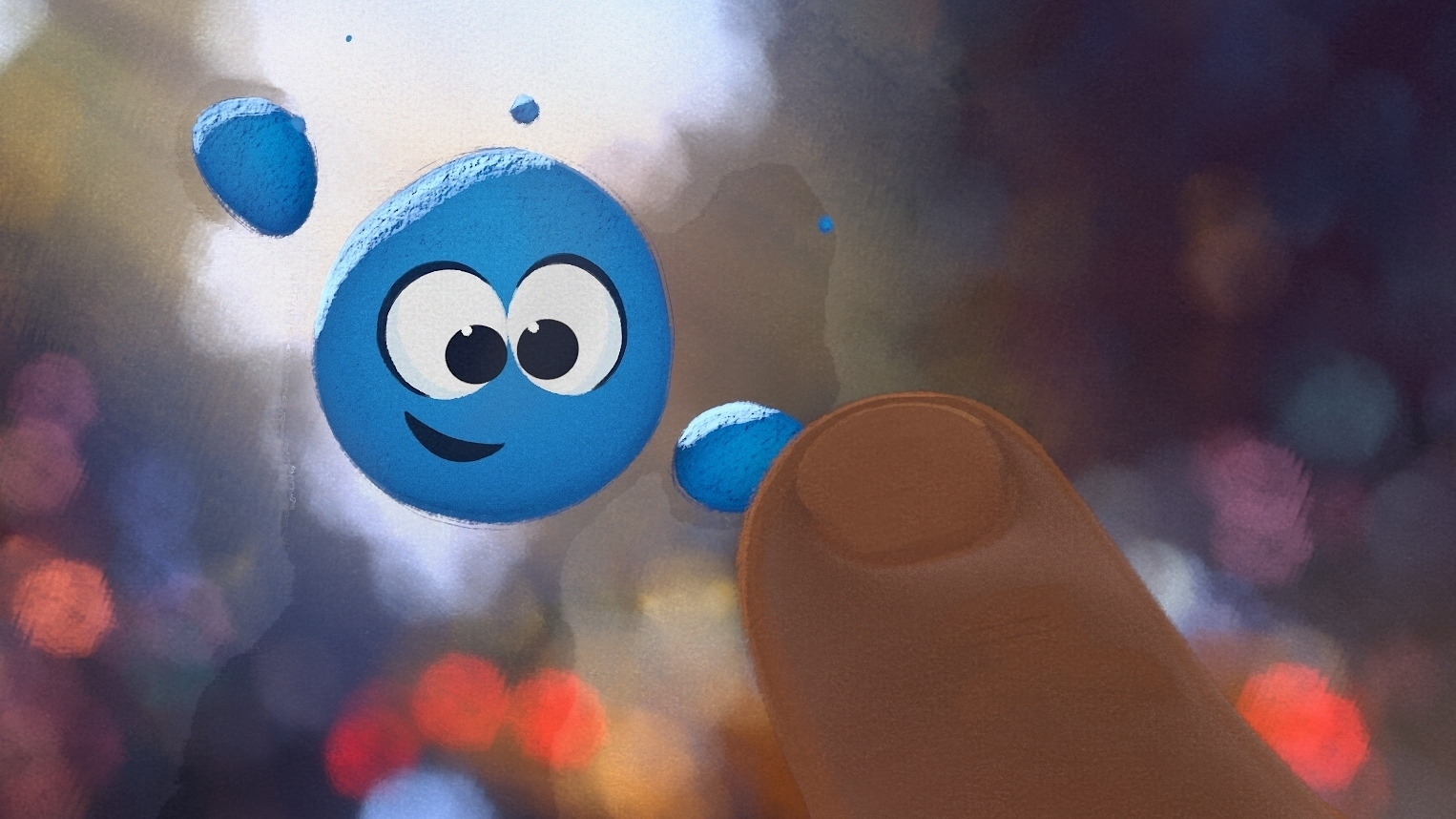Supervising Animator Trent Correy has been at Walt Disney Animation Studios since the first Frozen and leant his talents to Big Hero 6, Zootopia, Moana, Ralph Breaks the Internet, and Frozen 2. He was one of the first directors selected for the experiments Short Circuit program and his short Drop recently… well… dropped on Disney+. I spoke with Trent about his film during a recent visit to the animation studio in Burbank.
Alex: Drop has a 2D look, which to me is the hallmark of Disney Animation, but it's actually a CG film. Can you talk about how you were able to take a CG tool and make it look flat?
Trent Correy: Well of course, I’m assuming we’re close in age, growing up watching Disney, 2D is such a huge part of the legacy here and something I’m so excited about. And I started off my career working in 2D and then learning CG when I came to Disney. So I have this love and affinity and passion for 2D and a respect for what they do. There was a point up front on the film where I thought do we do this fully 2D? Do we do it fully CG? And where I landed was I really wanted to challenge our animation department to do something organic, something that feels 2D but is done in CG. So that’s where that came from because I knew we could do an organic raindrop in 2D, I knew we could do that. We haven’t seen that out of our CG rigs just because a lot of our features don’t have characters like that. That was kind of the main focus and then Meander came along basically because Jim Finn, my Art Director, pitched a painterly look to me and he wanted to paint all the backgrounds in his own style, which I loved, and thought how do we make the character look like that. That’s when we brought Meander on board and got that prepped to paint the character that way. Rachel Bibb is our Cleanup Artist in house who worked on many of these shorts and she did a lot of the cleanup and painting. It was just her and I working on that together.
Alex: While the film has a 2D look, it doesn’t replicate the look of cel animation. Can you talk more about Meander and what that does for you as an animator?’
Trent: Meander was developed during Paperman and it was meant as a tool where you could draw on top of the CG characters and it would stick to the computer characters. It helps you in-between a little bit and it helps give you that graphic look. So in Paperman they used it for the outlines, in Drop we decided to color in the characters so we did the opposite, we have no outlines but we painted the character that way. It wasn’t necessarily what the tool was designed to do so we did have to change a couple of interface things to make that work, but basically it gave us that painterly quality that I think could only be done by that hand drawn approach.
Alex: The main character has something that you don’t see often in CG which is detached limbs that have some kind of gravitational pull to the character. How complicated was it to rig a character like that and give it a lot of squash and stretch qualities?
Trent: That was the goal, actually. The goal with this was I wanted people to look at this and not quite know when it was 2D, when it was CG, when the backgrounds were painted, when they were CG backgrounds, and same with the effects, which were all hand drawn. There’s always a rig under anything with the character. When he’s in the gutter and you see the water, that’s all 2D. Anything with the character, including his arms and the little drops that come off him, those are all rigs. I’ve gotta hand it to Joy Johnson, who’s a rigger, came up with, in a very short amount of time, an R&D system that gave us that ability to oscillate, squash the rig, and basically make any shape out of this sphere character. And the animators… I mean, the animators studied water and there’s so many little cheats on how we break apart the character. Some of those scenes would have ten to twelve little raindrops that you’re animating. And it sounds complex but because it’s such a simple character… You know, humans have ten fingers and clavicles and hips and knee joints that we have to animate, because it’s just a sphere we’re able to make that work and spend a lot of time on the individual drops and stretch and squash. We broke down live-action reference of slow motion water, we looked at stuff that’s been done in the past in Fantasia, we looked at things like the Genie from Aladdin and Treasure Planet, the little character Morph. We looked at him a lot because that was such a successful organic character and we were like how do we do that in CG? That’s what’s so great about Short Circuit is you can kind of pick something you want to focus on and really experiment with it and a lot of people support that.
Alex: Because of the length of time since the last truly hand-drawn animated film on paper, there are some who say it could never truly come back. But I think Drop gives fans of that look hope that we could return to that visual esthetic. Do you think audiences today would be open to a longer format piece with this kind of look?
Trent: Yeah, I think what you’re seeing with the Short Circuits is a lot of people love 2D, I mean there’s 2D elements in everything we do, even the features. Whether I’m drawing at my desk doing thumbnails or the Story Artists are drawing, it’s not always the thing that makes it up on screen, its whatever medium services the story best. And what you’re seeing in Short Circuit is that experimental impassion for the shorter format and I think it’s only a matter of time before we see… There’s other studios exploring that option and we’re continuing to explore that here. It’s kind of all driven by the story and what the story needs and for my case, and you heard it with others, I like Mitch’s example with Fetch that he chose it to be hyper real and not use a 2D element because that informed his story, it made it scarier for the little girl. And I think everyone chooses these mediums based off the story elements. For water, I had actually gone down the route of maybe it’s a watercolor painting because that makes sense to try it that way. So the painterly look definitely supported the organic brush stroke feel.
Alex: On social media, I saw that you did something special for the artist that worked on your short. Can you talk about what you did to give back to the team?
Trent: Oh, the plushie… Almost all the Short Circuits have a little crew gift and we are, because we are the lucky directors that got picked to do these things, we’re so appreciative of the crews and I think that’s why we help out on any shorts that we can now. But we made plushies because who doesn’t want a raindrop plushie? It’s simple enough that I was like oh, I can get a friend to help me make these and we gave them out to the crew as a little surprise at the end. And we all went to the El Capitan and watched the premiere there with The Lion King. So it was a joy. And then you have something on your shelf, something tactile that you get to keep.
Alex: You see him in the intro to some of the other shorts.
Trent: He’s in some of the intros, yeah. A lot of the other shorts directors worked on the short. And you can only express your thanks so much by giving this small little token of appreciation.
Alex: The collaborative spirit of Walt Disney Animation Studios seems incredible and unique, not something that you find most places. What’s it been like to have people cheer you on and then become a cheerleader for the other Short Circuit directors?
Trent: It’s great. The energy at the studio in the past three years, and I think this program has a lot to do with it, is just amazing. It feels like more than ever people are pitching original ideas now and now we have different things like our shorts going to Disney+, different platforms to take advantage of. It’s amazing to know that half of the animation department is pitching ideas and someone will come ask me ‘Hey, do you mind hearing my pitch or doing a drawing for my pitch.’ And I’ll go to other people and ask the same thing. It’s very supportive and never feels competitive at all. I feel very thankful that a lot of the same people champion and be a part of my short. And now whenever I have free time at work, even if it’s like half a day where in the past I would’ve sketched or done my own thing, now I’m always trying to take that time and help someone else on their project. It is so gratifying to help a person out and help their vision be seen on screen.
Alex: What do you hope audiences take away from Drop when they see it on Disney+?
Trent: Well, I hope they get to experience the joy that we had making it. I’ve gotta say that we never thought these would be released. I made this thing three years ago knowing that it would only be internal. The fact that it’s going out there is such a huge joy and it’s kind of just a cherry on top. I had such a good time making it and it was the best three or four months that I had at the studio. I hope they can just feel the talent that goes with any of our features. I hope people can go and of course enjoy the story and take away something from it, but I hope they can just celebrate how many artists and technicians and support staff and everything support our films and there’s hundreds of hands behind all these. Specifically Drop, there’s thirty to forty people that worked very hard on it. That’s what I hope they take away, just smile. And I hope when they see rain in the car on their windshield, they put their finger on it and touch it.
You can stream Drop and the other Short Circuit films exclusively on Disney+.


